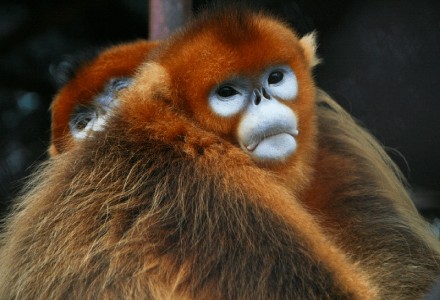
Photographer: Jack Hynes
CC License: https://bit.ly/1dMkpTr
Yunnan Golden Monkey Facts
- Firstly, the Yunnan Golden Monkey also bears other common names, including the Golden Snub-Nosed Monkey. This alternate name rather understandably derives from the unique flattened shape of the nose.
- Most notably, researchers believed this breathtaking primate to be extinct until the year 1962. However, at that time, local residents fortunately rediscovered its presence in the region, to their astonishment.
- In addition, and sadly, the IUCN currently lists the remarkable species as Critically Endangered. This ranking occurs due to a combination of its scant numbers and highly restricted habitat range.
- Finally, the nature of its habitat sets it apart from all other known primates. This consists of locations and conditions that most species would find extremely inhospitable to life.
Related Articles
Bald Uakari Lion Tailed Macaque Silvery Lutung
Photographer: su neko
CC License: https://bit.ly/3CDbHnW
Yunnan Golden Monkey Physical Description
First of all, the most distinctive feature of the Yunnan Golden Monkey remains its rather uniquely shaped nose. Yet this surprising physical characteristic does not rank as its only distinguishing feature.
Like many primates, the primate also displays sexual dimorphism. In its case, males average nearly twice the size of females. The males weigh as much as 44 lb (20 kg), while females rarely exceed 31 lb (14 kg).
Also, in coloring, the bodies of both genders display combinations of brown and white fur. The heads show a covering of golden-brown guard hairs. On the males, these guard hairs usually grow longer than those of the female.
- Kingdom: Animalia
- Phylum: Chordata
- Class: Mammalia
- Order: Primates
- Family: Cercopithecidae
- Genus: Rhinopithecus
- Species: R. roxellana
Photographer: Jack Hynes
CC License: https://bit.ly/1dMkpTr
Yunnan Golden Monkey Distribution, Habitat, and Ecology
The Yunnan Golden Monkey not only remains an impressive creature for its appearance, but for its hardiness, as well. That’s because it inhabits a highly restricted habitat range that consists of the high mountain ranges of Central and Southwest China, in Asia.
Within that range, however, it inhabits altitudes ranging from an astounding 4,921 – 11,483 ft (1,500 – 3,500 m). This range also includes extremely cold temperatures, as well as frequent snowfall.
Typically, the incredible animal prefers to form rather large groupings, which sometimes include as many as 600 individuals. These groupings usually defend their territory against other, rival ones.
Being herbivorous, its diet consists primarily of lichen, berries, twigs, fruit, bark, and occasionally insects. Finally, while an exact lifespan in the wild remains unknown, in captivity it lives an average of 23-26 years.
Species Sharing Its Range
Chinese Lantern Pallas Cat Binturong
Check out our other articles on 5 Incredibly Wonderful Trees, Indian Bullfrog, Gulper Eel, Mou Waho Island, Olive Ridley Sea Turtle, Giant Leopard Moth, African Penguin

